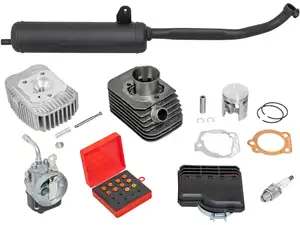
PIAGGIO
The Piaggio family - an honourable society
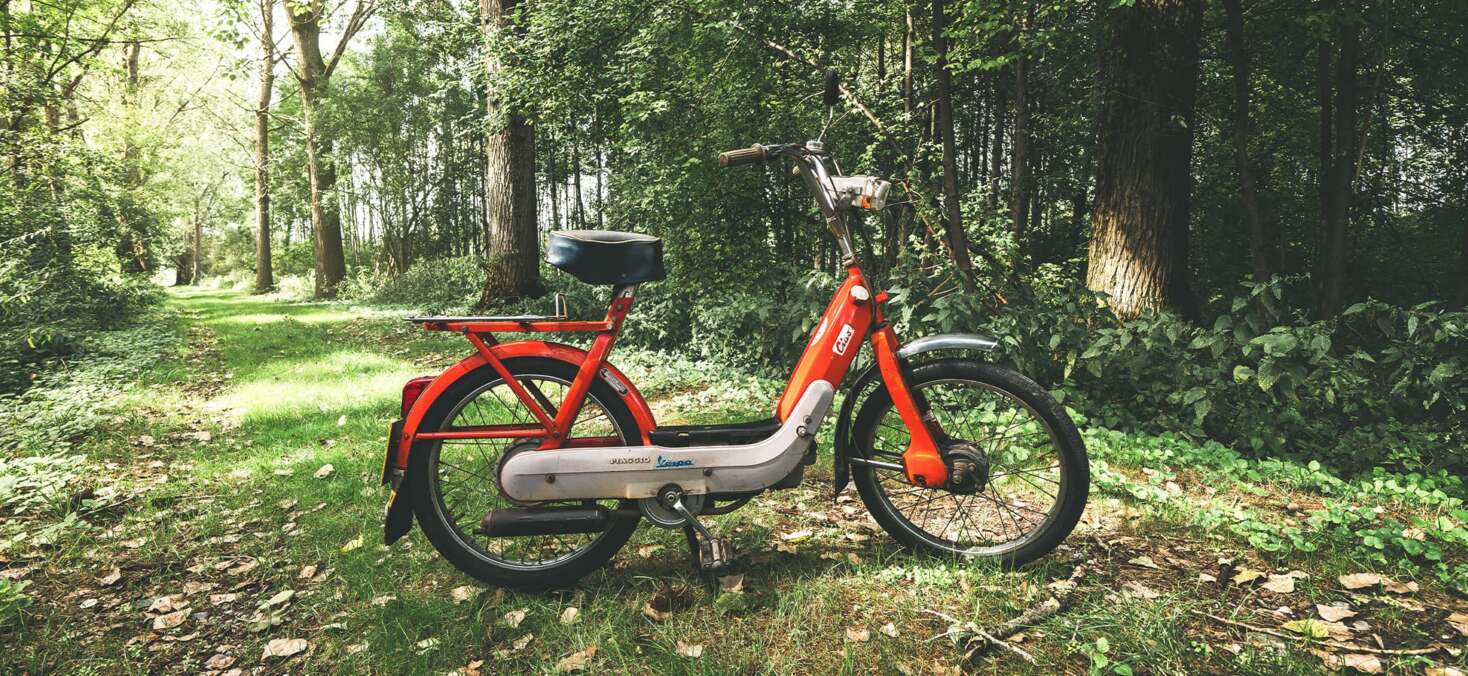
Boxer, Bravo, Si or Ciao - when one of the legendary moped models from the world's most famous moped manufacturer turns round the next street corner, the eyes of every moped enthusiast light up. Because the Piaggio two-strokes from the tranquil little town of Pontedera in Tuscany are undoubtedly among the most popular and endearing motorbikes of all. Even though production has long since ceased, the Italo-moped can still be found comparatively frequently on Swiss roads, thanks to the many enthusiasts who own one of the legendary bikes and are passionate about keeping them in roadworthy condition. We introduce you to the iconic manufacturer and its bikes in more detail.
| Seat |  |
| Status | |
| Foundation | 1884 |

The beginnings of a legendary two-wheel forge
From the very beginning of the company's long and glorious history, Piaggio was dedicated to vehicle construction. However, it was several years before the Italian engineers began developing two-stroke two-wheelers. After the company was founded in Genoa in 1884, Piaggio initially concentrated on shipbuilding and the manufacture of railway carriages. Company founder Rinaldo Piaggio proved to have the right instinct when he established a new plant at the future headquarters in Pontedera in 1916, where he developed aeroplanes and components for aviation, a revolutionary and innovative technology at the time. One of the most important customers in the following decades was the Italian army. For Piaggio, this meant lucrative business, which guaranteed a healthy income and rapid expansion, at least until the end of the Second World War, which also left Italy a devastated and destroyed country.
Malossi tuning set 43 mm | Piaggio Ciao, Bravo, Boxer
Manufacturer: Dell'Orto · Manufacturer: Malossi · Manufacturer: NGK · Manufacturer: SITO · Manufacturer: swiing · Area of application: Tuning · Displacement: 65 ccm · Nominal diameter: 65 mm · Ø piston pin (B): 10 mm · Ø piston pin (B): 12 mm · Camouflaged: No
CHF 354.90
Not in stock
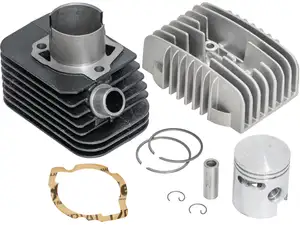
Olympia 43 mm cylinder kit incl. head 10 mm KoBo | Piaggio SI, Bravo, Grillo
Manufacturer: Olympia · Camouflaged: No · Surface: varnished · Area of application: Tuning · Crankshaft stroke: 43 mm · Nominal diameter: 43 mm · Displacement: 63 ccm · Ø piston pin (B): 10 mm · Material: Gray cast iron · Ø cylinder neck: 46 mm · Ø Outlet outside: 22.3 mm · Number of fixing points: 3 pcs · Outlet type: clamped · Decompressor: Yes
CHF 149.90

Olympia 43 mm cylinder kit incl. head 12 mm KoBo | Piaggio Ciao, Bravo, Boxer
Manufacturer: Olympia · Camouflaged: No · Surface: varnished · Area of application: Tuning · Crankshaft stroke: 43 mm · Nominal diameter: 43 mm · Displacement: 63 ccm · Ø piston pin (B): 12 mm · Material: Gray cast iron · Ø cylinder neck: 46 mm · Ø Outlet outside: 22.3 mm · Number of fixing points: 3 pcs · Outlet type: clamped · Decompressor: Yes
CHF 139.90
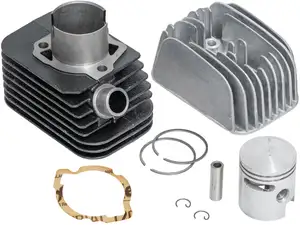
Olympia 43 mm cylinder kit incl. head 10 mm KoBo | Piaggio Ciao, Bravo, Boxer
Manufacturer: Olympia · Camouflaged: No · Surface: varnished · Area of application: Tuning · Crankshaft stroke: 43 mm · Nominal diameter: 43 mm · Displacement: 63 ccm · Ø piston pin (B): 10 mm · Material: Gray cast iron · Ø cylinder neck: 46 mm · Ø Outlet outside: 22.3 mm · Number of fixing points: 3 pcs · Outlet type: clamped · Decompressor: Yes
CHF 139.90
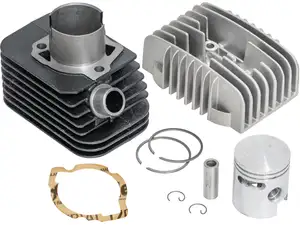
Olympia 43 mm cylinder kit incl. head 12 mm KoBo | Piaggio SI, Bravo, Grillo
Manufacturer: Olympia · Camouflaged: No · Surface: varnished · Area of application: Tuning · Crankshaft stroke: 43 mm · Nominal diameter: 43 mm · Displacement: 63 ccm · Ø piston pin (B): 12 mm · Material: Gray cast iron · Ø cylinder neck: 46 mm · Ø Outlet outside: 22.3 mm · Number of fixing points: 3 pcs · Outlet type: clamped · Decompressor: Yes
CHF 149.90
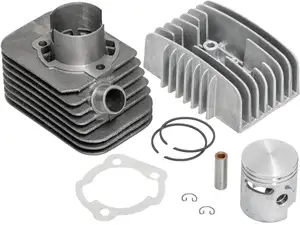
Polini 43 mm cylinder kit incl. head 10 mm KoBo | Piaggio SI, Bravo, Grillo
Manufacturer: Polini · Material: Gray cast iron · Surface: sandblasted · Displacement: 63 ccm · Crankshaft stroke: 43 mm · Nominal diameter: 43 mm · Number of fixing points: 3 pcs · Ø piston pin (B): 10 mm · Outlet type: clamped · Area of application: Tuning · Decompressor: Yes · Camouflaged: No
CHF 214.90
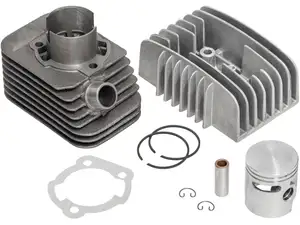
Polini 43 mm cylinder kit incl. head 12 mm KoBo | Piaggio SI, Bravo, Grillo
Manufacturer: Polini · Material: Gray cast iron · Surface: sandblasted · Displacement: 63 ccm · Crankshaft stroke: 43 mm · Nominal diameter: 43 mm · Number of fixing points: 3 pcs · Ø piston pin (B): 12 mm · Outlet type: clamped · Area of application: Tuning · Decompressor: Yes · Camouflaged: No
CHF 214.90
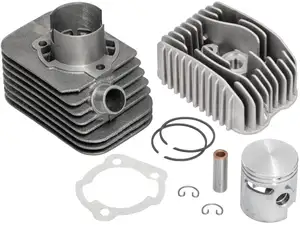
Polini 43 mm cylinder kit incl. head 12 mm KoBo | Piaggio Ciao, Bravo, Boxer
Manufacturer: Polini · Material: Gray cast iron · Surface: sandblasted · Displacement: 63 ccm · Crankshaft stroke: 43 mm · Nominal diameter: 43 mm · Number of fixing points: 3 pcs · Ø piston pin (B): 12 mm · Outlet type: clamped · Area of application: Tuning · Decompressor: Yes · Camouflaged: No
CHF 224.90
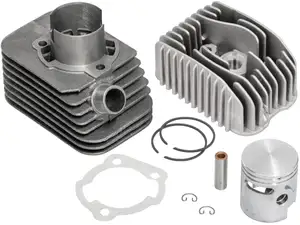
Polini 43 mm cylinder kit incl. head 10 mm KoBo | Piaggio Ciao, Bravo, Boxer
Manufacturer: Polini · Material: Gray cast iron · Surface: sandblasted · Displacement: 63 ccm · Crankshaft stroke: 43 mm · Nominal diameter: 43 mm · Number of fixing points: 3 pcs · Ø piston pin (B): 10 mm · Outlet type: clamped · Area of application: Tuning · Decompressor: Yes · Camouflaged: No
CHF 224.90
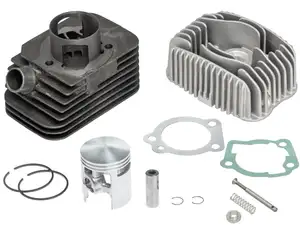
Malossi 43 mm cylinder kit incl. head 10 mm KoBo new version | Piaggio Ciao, Bravo, Boxer
Manufacturer: Malossi · Material: Aluminum · Material: Gray cast iron · Area of application: Tuning · Displacement: 63 ccm · Crankshaft stroke: 43 mm · Nominal diameter: 43 mm · Number of fixing points: 3 pcs · Ø piston pin (B): 10 mm · Outlet type: clamped · Camouflaged: No
CHF 199.90
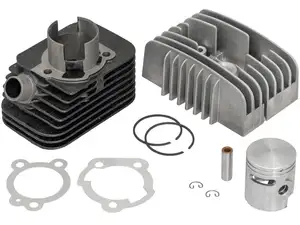
Polini Racing 43 mm cylinder kit incl. head 10 mm KoBo | Piaggio SI, Bravo, Grillo
Manufacturer: Polini · Material: Gray cast iron · Surface: sandblasted · Displacement: 63 ccm · Crankshaft stroke: 43 mm · Nominal diameter: 43 mm · Ø cylinder neck: 45.7 mm · Ø Outlet outside: 22.4 mm · Number of fixing points: 3 pcs · Ø outlet inside: 18.1 mm · Ø piston pin (B): 10 mm · Outlet type: clamped · Hole pattern [mm]: 55 x 34 · Area of application: Tuning · Decompressor: Yes · Camouflaged: No
CHF 239.90
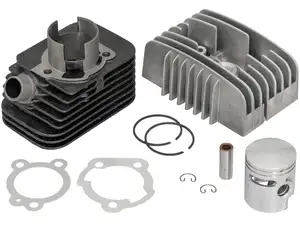
Polini Racing 43 mm cylinder kit incl. head 12 mm KoBo | Piaggio SI, Bravo, Grillo
Manufacturer: Polini · Material: Gray cast iron · Surface: sandblasted · Displacement: 63 ccm · Crankshaft stroke: 43 mm · Nominal diameter: 43 mm · Ø cylinder neck: 45.7 mm · Ø Outlet outside: 22.4 mm · Number of fixing points: 3 pcs · Ø outlet inside: 18.1 mm · Ø piston pin (B): 12 mm · Outlet type: clamped · Hole pattern [mm]: 55 x 34 · Area of application: Tuning · Decompressor: Yes · Camouflaged: No
CHF 239.90
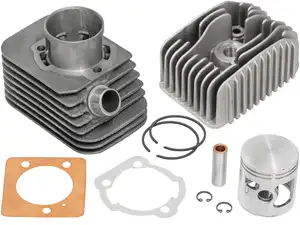
Polini 46 mm cylinder kit incl. head 12 mm KoBo | Piaggio Ciao, Bravo, Boxer
Manufacturer: Polini · Material: Gray cast iron · Surface: sandblasted · Displacement: 70 ccm · Crankshaft stroke: 43 mm · Nominal diameter: 46 mm · Number of fixing points: 3 pcs · Ø piston pin (B): 12 mm · Outlet type: clamped · Area of application: Tuning · Decompressor: Yes · Camouflaged: No
CHF 239.90
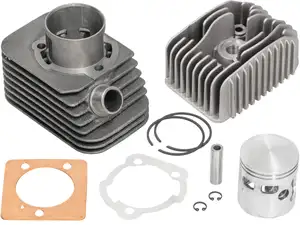
Polini 46 mm cylinder kit incl. head 10 mm KoBo | Piaggio Ciao, Bravo, Boxer
Manufacturer: Polini · Material: Gray cast iron · Surface: sandblasted · Displacement: 70 ccm · Crankshaft stroke: 43 mm · Nominal diameter: 46 mm · Number of fixing points: 3 pcs · Ø piston pin (B): 10 mm · Outlet type: clamped · Area of application: Tuning · Decompressor: Yes · Camouflaged: No
CHF 239.90
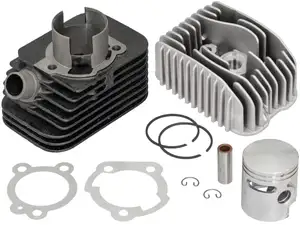
Polini Racing 43 mm cylinder kit incl. head 12 mm KoBo | Piaggio Ciao, Bravo, Boxer
Manufacturer: Polini · Material: Gray cast iron · Surface: sandblasted · Displacement: 63 ccm · Crankshaft stroke: 43 mm · Nominal diameter: 43 mm · Ø cylinder neck: 45.7 mm · Ø Outlet outside: 22.4 mm · Ø outlet inside: 18.1 mm · Ø piston pin (B): 12 mm · Outlet type: clamped · Hole pattern [mm]: 55 x 34 · Area of application: Tuning · Decompressor: Yes · Camouflaged: No · Number of fixing points: 3 pcs
CHF 239.90
Page 1 of 136
Children of the post-war era: Vespa and Ape
However, the future moped manufacturer from Pontedera quickly got back on its feet; in a way, the war damage to the Italian infrastructure was even partly responsible for the rapid consolidation of the company after the end of the war. Enrico, son of company founder Rinaldo Piaggio, who had meanwhile taken over the business from his father, realised that motorised two-wheelers were the only class of vehicle that could be relied on to get around in a country with roads damaged by bomb craters and blocked by mountains of rubble. The response of the engineers from Pontedera to this situation was the legendary ‘Wasp’, better known as the Vespa scooter. The two-wheeler was launched on the market in 1946 and immediately became a bestseller. It was followed two years later by the ‘Bee’, or il modello di ciclomotore Ape, as the Italians would say. This three-wheeled microcar, which has long since become an icon in vehicle construction, could also be used to transport smaller loads thanks to its characteristic loading area.
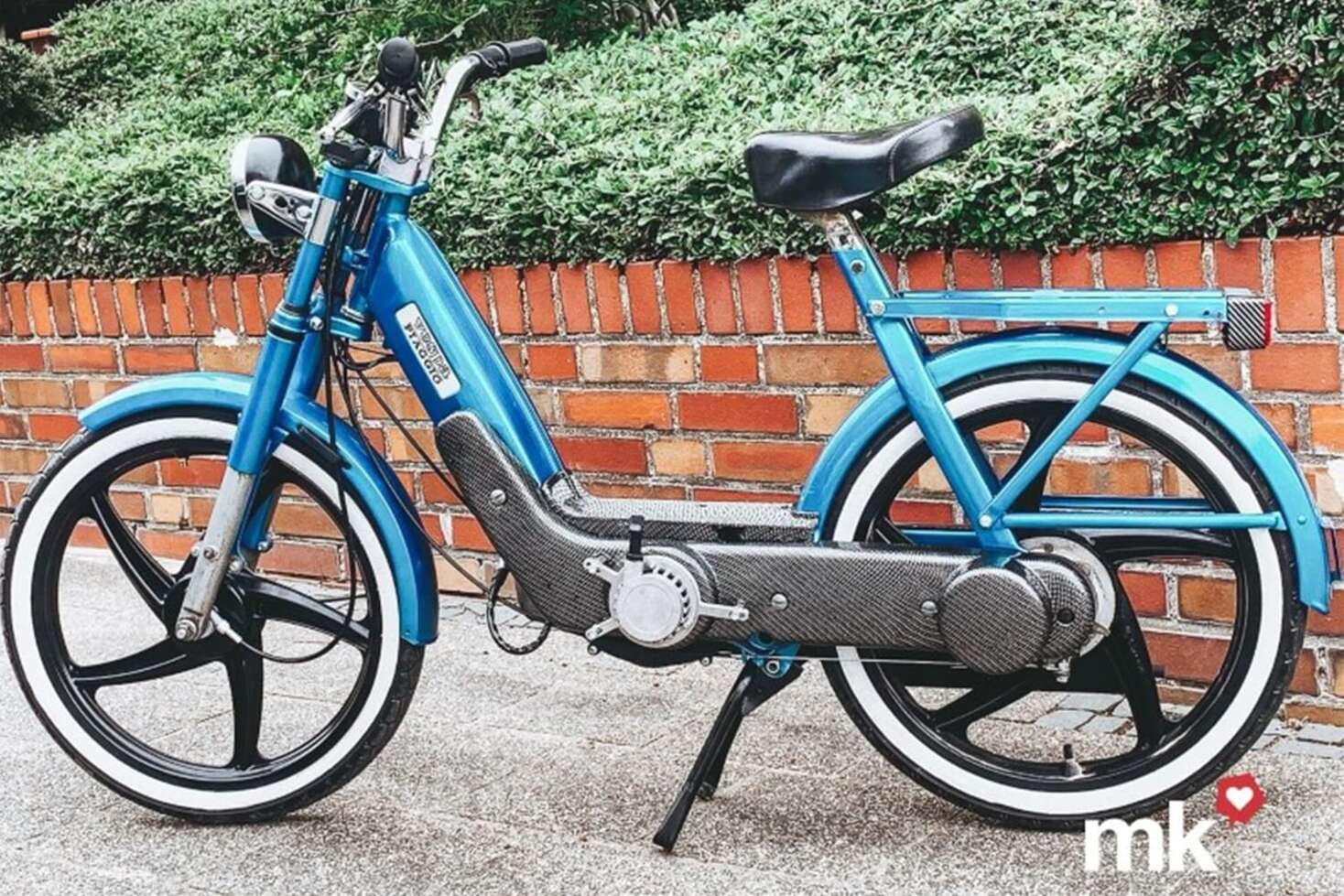
The first mopeds are built
Vespa and Ape played a major role in the steady rise of the company, which seemed to know no bounds. As early as the 1950s, the manufacturer was Italy's leading producer of two-wheelers. Possibly intoxicated by this success, the company also tried its hand at four-wheeled vehicles. The result was the Vespa 400, which came onto the market in 1957. However, this wasp did not sting, but rather ended up as a road flea. The concept was cancelled as early as 1961 and production was discontinued. In Pontedera, the focus returned to the core competence: vehicles on two wheels! From today's perspective, the Italian vehicle manufacturers made the absolutely right decision. Because in 1968, the Italian engineers launched the first genuine moped. A gem that was to become one of the most famous, most produced and most sought-after mopeds ever: the Piaggio Ciao!
The gem of gems: the Ciao moped
The legendary Ciao moped was to be produced in five different series and numerous versions until 2006. The mopeds of the first series, which were built until 1975, were divided into the model variants ‘A’ (19-inch rims), ‘L’ (17-inch rims) and ‘SC’. In terms of equipment and appearance, the first two variants differed in that the L version also had front wheel suspension and chrome mudguards. The SC version (Super Confort) also had a sprung saddle. With the following model series, the Ciao motorbikes became more and more comfortable, and the suspension in particular was continuously improved. Of course, the technology also continued to develop over the years. Changes were made with each model series. However, the constants of the Piaggio Ciao include the Dell'Orto SHA 12.10 carburettor, the rotary valve-controlled 2-stroke engine and the V-belt drive, which is typical of many Piaggio models. In the early years, M1M units were installed, which delivered an output of 1.1 hp. Newer models were somewhat more powerful, with the single-cylinder 2-stroke delivering 1.36 hp at 4000 rpm.
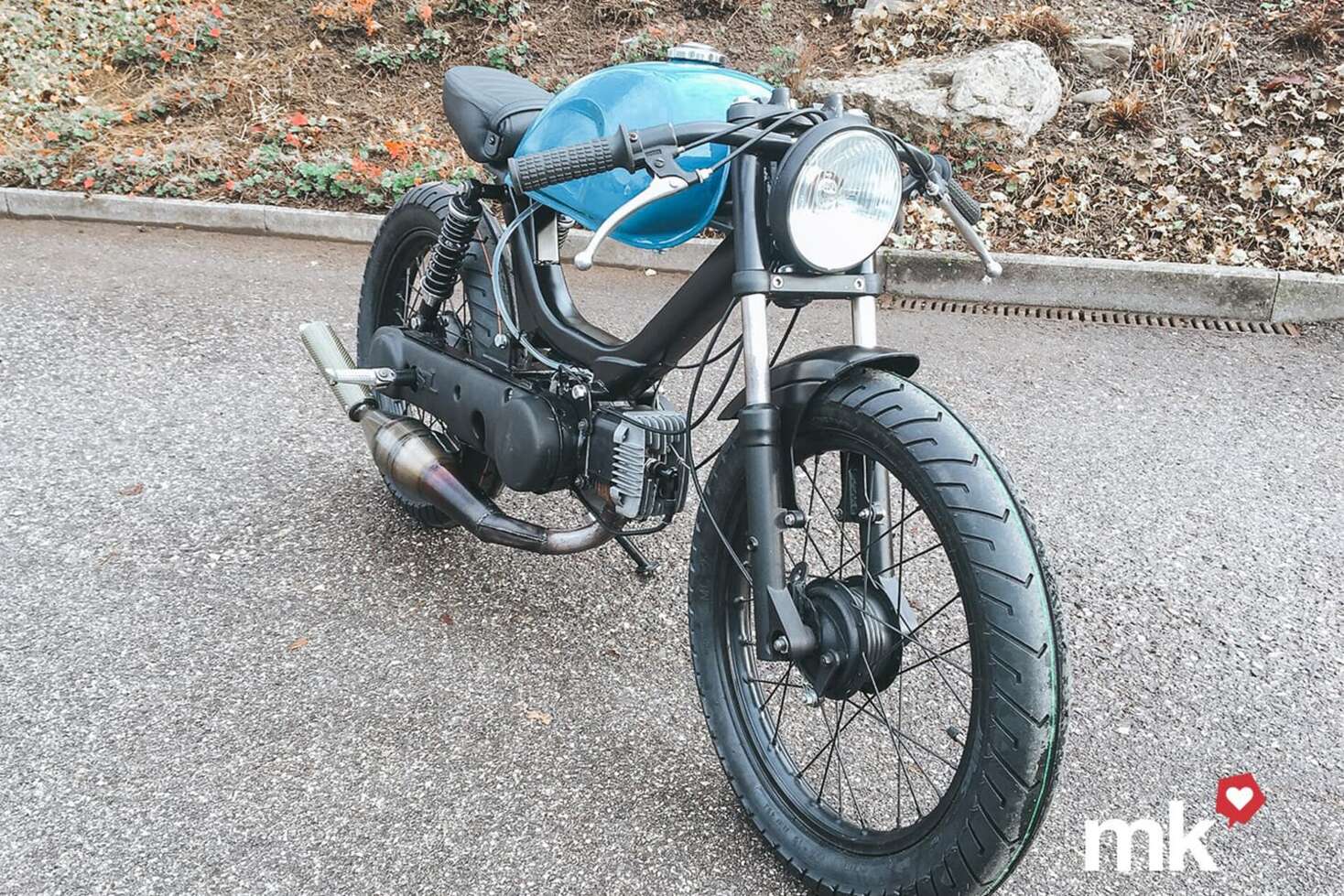
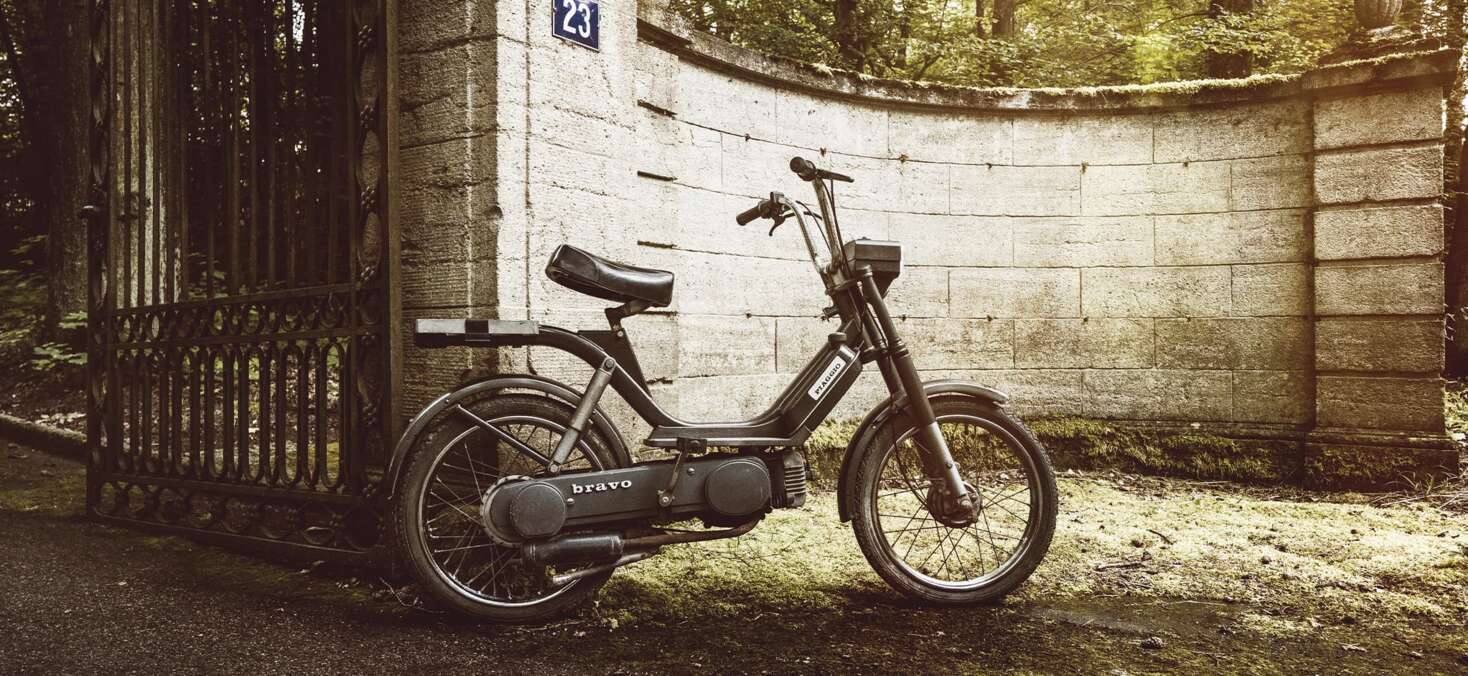
Piaggio is more than the Ciao moped
In addition to the Ciao moped, which is certainly the most popular and best-known two-wheeler from the moped manufacturer in Pontedera, Piaggio also gave the world several other moped models. The Bravo, Si and Boxer mopeds are often somewhat unfairly overshadowed by the famous Ciao moped.

The Bravo model
Spurred on by the success of the Piaggio Ciao moped, the Italians introduced the Bravo moped in 1973. The originally rather spartan moped - the ‘A’ models of the first series had no suspension at all - was also built for a long time until 1981. The moped was motorised in the same way as the Ciao moped; a special feature of this series was the Super Bravo model, which was launched as part of the fourth and final series. This was one of the first mass-produced cross mopeds.
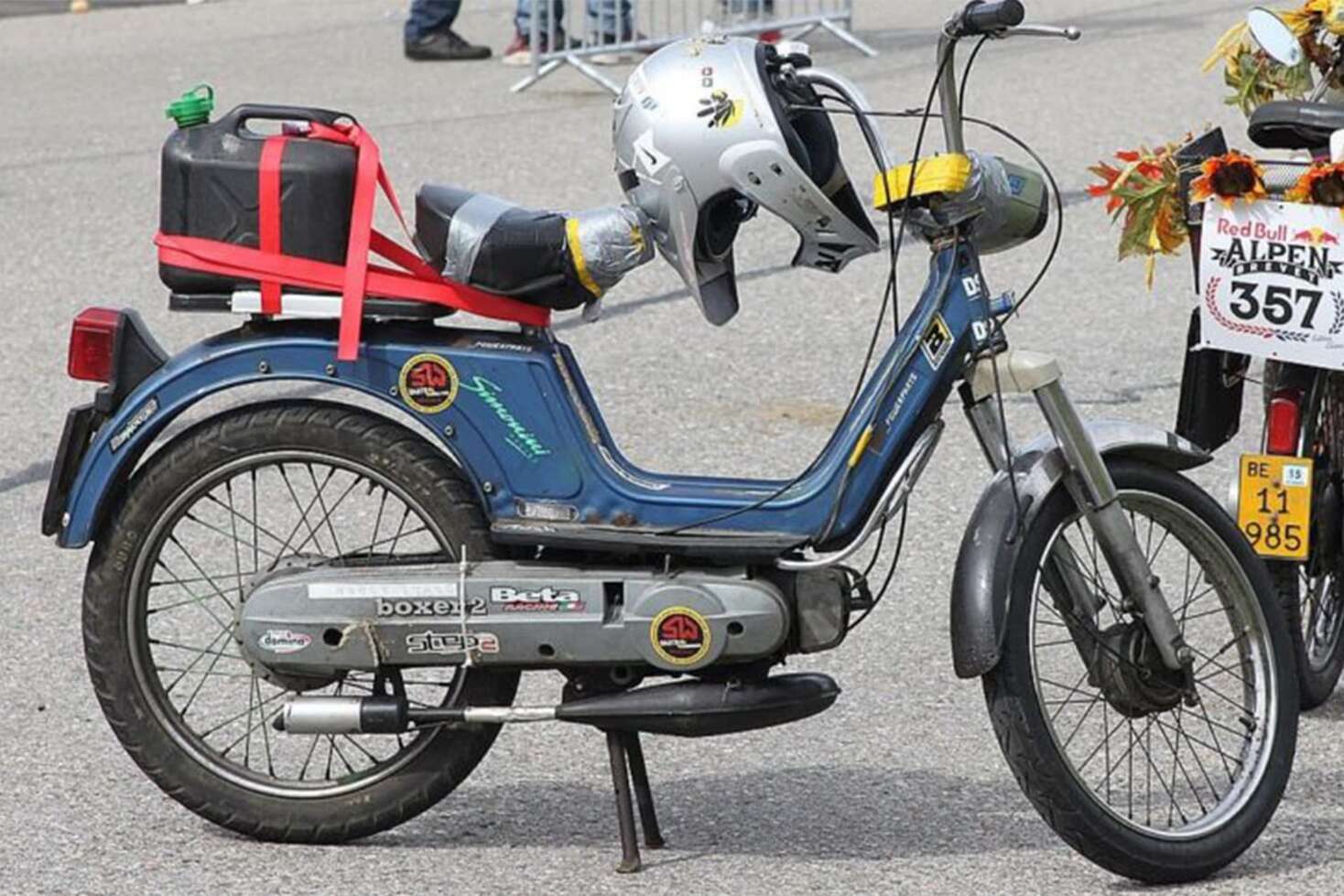
The Super Bravo moped was delivered from the factory with thick studded tyres and powerful shock absorbers. But to be honest, although this model clearly stood out visually from its predecessors and the other Piaggio models, it was only suitable for off-road riding to a limited extent, at least if you use today's cross bikes as a yardstick.
The Boxer and Si models
The Piaggio Boxer moped is much shorter - and therefore much rarer to admire on Swiss roads today. Contrary to what the name might suggest, this moped has a rather slim silhouette and, with an unladen weight of 50 kg, is one of the lightest motorbikes in the Piaggio family. The models of the first series left the factory in Pontedera in 1970 and were replaced in 1972 by the successor model, the Boxer 2, which was produced until 1978. As with the Bravo moped, the Boxer pearl was also equipped with a plastic fuel tank. When the last Boxer moped rolled off the production line, the Italians launched the Si moped as the successor model. It had inherited the somewhat slimmer silhouette from the Boxer moped, but the engineers orientated themselves technically more towards the Ciao moped. A fact that benefits every enthusiast who owns a Si gem, as the technical relationship makes it much easier to source spare parts.
Popular PIAGGIO topics













